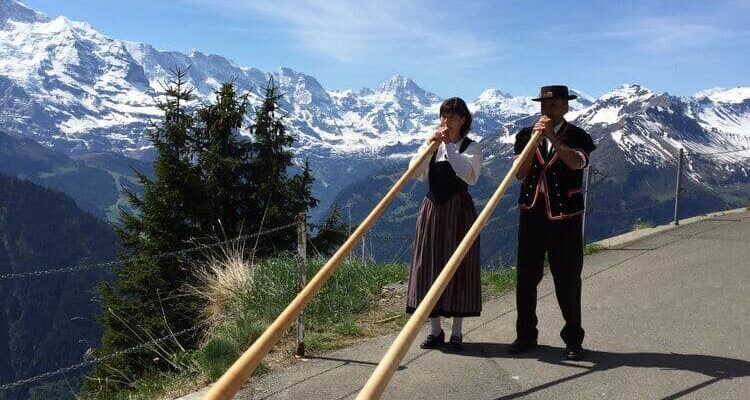The Alps, majestic mountains that occupy a central place in the heart of Europe, have always inspired people to create. Not only do they offer natural beauty, but they also influence the musical traditions of the regions surrounding these mountain ranges. The sounds of the mountains can be heard in the traditional melodies sung by shepherds, in the rhythms of folk dances, and in the unique sound of Alpine instruments. Alpine music is a unique part of cultural heritage passed down through generations. In this article, we will talk about the musical traditions of the Alpine regions, including the Czech Republic, and how the mountains have become an integral part of musical culture.
History and Influence of the Mountains on Music
The Alps span several countries, including Switzerland, Austria, France, Italy, and Germany, and each region has contributed its own unique musical tradition. Since ancient times, the mountains have served as a source of inspiration for many peoples, and their special atmosphere has been reflected in music. In the Alpine regions, isolated communities often live, which leads to the development of unique musical styles shaped by the local nature and culture.
Traditional melodies in the Alpine regions were often passed down orally, from the older generation to the younger. These included pastoral compositions, musical works accompanying agricultural tasks, and of course, specific tunes that accompanied holidays and rituals. The key instruments in these traditions were the Alpine horn, flutes, and various types of wind and string instruments.
The Alpine Horn: A Symbol of the Mountain Landscape
One of the most recognizable symbols of the Alpine musical tradition is the Alpine horn. This long wind instrument, popular in Alpine countries, has a remarkable, deep, and rich sound that can be heard from great distances. The horn, which can be several meters long, was originally used by shepherds to communicate between mountain communities and to call livestock.
The sound of the Alpine horn is perceived as the embodiment of the very nature of the mountains — its powerful yet soft tones evoke the echo in the valleys and gorges. This instrument is still widely used in traditional festivals, such as Switzerland’s “Alphornfest,” where musicians gather to demonstrate their mastery of the horn.
Shepherds’ Music and Folk Tradition
Shepherds played an important role in the life of the Alpine regions, and their music was always an integral part of the culture. Traditional shepherd songs accompanied their everyday life and work. These melodies were often simple, yet expressive, allowing shepherds to convey emotions and feelings while being far from civilization. The songs were often dedicated to nature, the beauty of the mountains, and the various events in the life of the rural community.
The traditions of shepherd music have survived to this day, especially in countries like Switzerland and Austria. In the Czech Republic, while shepherds do not play as prominent a role, folk music traditions are also deeply rooted in the region’s history. The Czech Republic, being in the center of Europe, absorbed many musical influences, and elements of Alpine musical culture can also be found in Czech folklore.
Festivals and Rituals
Alpine regions are famous for their numerous festivals and rituals, where music plays a central role. One of the most vivid examples is the “Almabtrieb” festival in Austria and Germany. This event, marking the descent of livestock from the mountain pastures to the valleys for the winter, is accompanied by a vibrant musical procession. Shepherds and villagers dress in traditional costumes and play instruments such as flutes, harmonicas, and of course, the Alpine horn.
Moreover, Alpine countries are particularly known for their folk festivals, where musicians and dancers gather to showcase their skills. These festivals are often an important part of cultural life and a way to preserve traditions.
Music in the Czech Republic: The Influence of Alpine Culture
The Czech Republic, located near the Alpine mountains, is not part of the Alpine system itself, but the cultural influence of the Alpine regions is also felt here. Czechs, like other European peoples, have adopted many musical traditions, including the use of certain Alpine instruments and rhythms. For example, in Czech folk songs, one can often find motifs characteristic of Alpine music.
In some Czech villages, especially in the mountainous regions, locals preserve traditions of shepherd music and rituals related to mountain farming. Czech folk ensembles, inspired by Alpine motifs, often use instruments similar to the Alpine horn, such as horned trumpets and various wind instruments.
Conclusion
Alpine music is not just a sound coming from the mountain peaks. It is a part of the cultural identity of the peoples who live in these areas, and an important part of European cultural heritage. The sounds of the mountains continue to inspire modern musicians, and the traditions of Alpine music live on and develop despite the challenges of time. The Czech Republic, like other European countries, continues to maintain these traditions, adding new elements to them, and thus preserving the rich musical heritage connected to the Alps.

